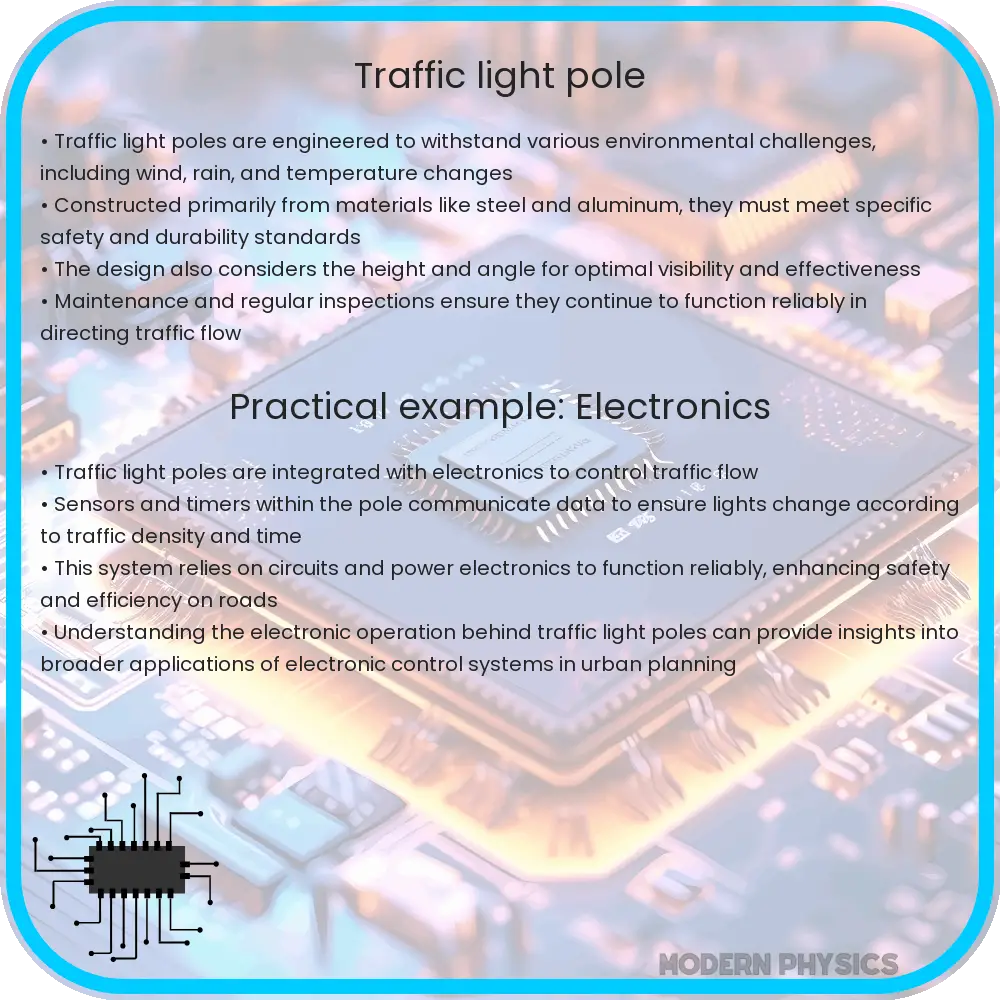Explore the design, durability, and safety of traffic light poles, including load calculations, material choices, and innovative technologies.

Traffic Light Pole: Understanding Durability, Load Calculation, and Safety
Traffic light poles are a critical component of urban infrastructure, serving as the backbone for traffic signals and other roadway indicators. Their design and construction must adhere to stringent standards to ensure they withstand environmental challenges and operational stresses. This article delves into the key aspects of traffic light pole durability, load calculation, and safety considerations.
Durability of Traffic Light Poles
The durability of traffic light poles is paramount, as they are exposed to various environmental conditions such as extreme weather, corrosion, and physical impacts. Materials used in pole construction play a significant role in determining their longevity and maintenance requirements. Common materials include galvanized steel, aluminum, and reinforced concrete, each offering distinct advantages in terms of strength, weight, and resistance to corrosion.
Galvanized steel poles are widely used due to their excellent strength-to-weight ratio and corrosion resistance, which is achieved through a coating of zinc. This layer acts as a sacrificial anode, protecting the steel from rust. Aluminum poles, while lighter and naturally resistant to corrosion, may require additional treatments for enhanced durability in harsh environments. Reinforced concrete poles offer exceptional strength and durability, making them suitable for areas prone to severe weather conditions or high wind loads.
Load Calculation for Traffic Light Poles
Load calculation is a critical step in the design and installation of traffic light poles. This process involves determining the maximum load a pole can safely support, taking into account factors such as the weight of the traffic lights, wind speed, and any additional fixtures like signs or cameras. The calculation must adhere to regional engineering standards and safety codes.
Engineers use various formulas and modeling software to estimate the wind load on a pole. The basic formula is P = 0.613 * Kz * Kzt * Kd * V2 * A, where P is the wind pressure, Kz is the exposure coefficient, Kzt is the topographic factor, Kd is the wind directionality factor, V is the wind speed, and A is the effective projected area of the pole and fixtures.
Accurate load calculation is essential to ensure the pole’s structural integrity and prevent failures, which can lead to accidents or service disruptions. It’s also important for economic efficiency, as overestimating the required strength can lead to unnecessary costs, while underestimating it can compromise safety.
Safety Considerations for Traffic Light Poles
Safety is a critical concern in the design and installation of traffic light poles. This encompasses not only the structural safety of the pole itself but also its impact on public safety. Poles must be designed to withstand accidental impacts, such as vehicle collisions, without posing additional hazards. Breakaway bases are often used to ensure that a pole will safely collapse upon impact, minimizing the risk to motorists and pedestrians.
Regular maintenance and inspections are also vital to maintaining the safety and functionality of traffic light poles. This includes checking for signs of wear and tear, corrosion, and damage from impacts or environmental factors. Timely repairs and replacements are crucial to prevent malfunctions or collapses, which can have serious safety implications.
Environmental and Regulatory Compliance
Environmental considerations and regulatory compliance are also critical factors in the design and installation of traffic light poles. Environmental factors like temperature fluctuations, humidity, and exposure to pollutants can affect the durability and functionality of these structures. Manufacturers and installers must ensure that their products and practices comply with local environmental laws and standards, such as emissions during manufacturing or the use of environmentally friendly materials.
In terms of regulatory compliance, traffic light poles must meet specific standards and guidelines set by governmental transportation and safety authorities. These regulations may include requirements for height, strength, visibility, and resistance to environmental factors. Compliance with these standards ensures that the poles are safe for public use and effective in their role in traffic management.
Innovations in Traffic Light Pole Design
Technological advancements have led to innovations in traffic light pole design, enhancing their efficiency, durability, and functionality. Smart poles, equipped with sensors and communication technology, are becoming more common. These poles can monitor traffic conditions, weather, and even air quality, providing valuable data for city management and maintenance crews. Additionally, the integration of renewable energy sources, such as solar panels, is an emerging trend, making traffic light systems more sustainable and less dependent on the electrical grid.
Light-emitting diode (LED) technology is also being increasingly used in traffic signals due to its energy efficiency and longevity. This reduces the maintenance needs and operational costs of traffic light systems while ensuring high visibility and reliability.
Conclusion
In conclusion, traffic light poles are a vital component of urban infrastructure, requiring careful consideration of durability, load calculation, and safety. The choice of materials, accurate load calculations, and adherence to safety standards are essential to ensure their long-term functionality and safety. Environmental and regulatory compliance further ensure that these structures meet the necessary legal and ethical standards. Innovations in technology, such as smart poles and LED lighting, are enhancing the efficiency and capabilities of traffic light systems, paving the way for more sustainable and intelligent urban traffic management. As cities continue to grow and evolve, the role of traffic light poles in ensuring safe and efficient transportation will remain indispensable.
